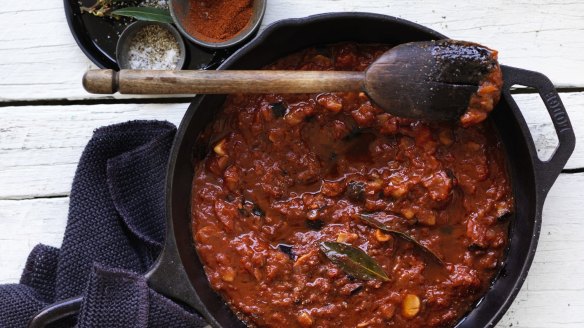How to take the sting out of a boozy pasta sauce

When I add wine to my pasta sauce it tastes very alcoholic, no matter how long I cook it. H. Kacper.
I do love the theatre of burning off alcohol by adding it to a hot pot – an incandescent flash of heat and colour that is actually completely useless in achieving what it purports to do. Now, deglazing with wine is another matter. After the base sauce ingredients of carrot, celery and onion have cooked, add a splash of wine to the pan and stir with a wooden spoon to dissolve or "deglaze" the browned sugars and protein coating the base of the pan. This is where so much flavour lies and if you don't remove this "glazing" then food can catch or stick to the base. By adding wine to the hot pan a lot of the alcohol does evaporate but to get rid of all the alcohol you really need to reduce the wine to almost nothing. Some cooks make the mistake of adding the wine to the sauce after the stock and other wet ingredients are added. It is really hard to evaporate alcohol when it is mixed with water. The molecules in the ethanol in wine interfere with the water molecules, making it easier for the water molecules to evaporate away from the sauce. This is despite alcohol having a boiling point of 78C, much lower than water's 100C. So deglaze, reduce and evaporate the wine, brandy, port or whatever and then add the stock and tomatoes.
Why add butter and oil when frying? P. Levy
Because butter tastes so good. Extra virgin olive oil has a smoke point (or burning point) of between 200C and 210C, while butter has a smoke point of about 150C. By combining the two, some say it increases the smoke point of butter. It doesn't. Butter is about 80 to 85 per cent fat. The rest is water, protein, a tiny amount of lactose, salt and minerals. As the butter melts, the water evaporates, the fat gets hotter and the protein and other solids burn. Even with added olive oil the protein will burn, leaving the butter dark. What the olive oil does do is dilute the butter, meaning there are fewer solids to burn. Many chefs are turning to ghee, which is butter with the water and solids removed and has a smoke point of 250C.
Letters
There has been a lot of correspondence around the missing "e" in steak tartar. J.J. Portail weighed in to say, "contrary to what Monsieur Plutte told you, there is not such a thing in French as 'boeuf tartar'. It is either 'steak tartare' or 'tartare de boeuf'. The reason there is an e at the end of tartare, is because steak tartare is a contraction of steak a la tartare ('tartare-style'). The same applies for many other recipes like tomatoes provencale, or poulet basquaise."
Send your vexing culinary conundrums to brainfood@richardcornish.com.au or tweet to @realbrainfood.
Appears in these collections
- More:
- Food
- Brain food
